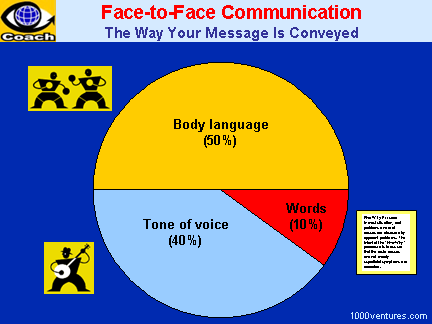|
Advantages
you can
gain from tracking "eye accessing cues"
By Michael Lovas3 |
-
Know
when to stop talking – people who prefer visual
information can't easily comprehend a lot of talking. The more
you talk to them, the lower your chances of making a sale. So,
ask more questions, and when you talk, be brief and effective.
-
Watching the other person closely
helps you
connect
with that person. People who feel as
though they're being honestly listened to tend to like the person listening, and trust
that person more easily.
-
Watching the other person closely
makes it harder for you to make the
biggest mistake – jumping ahead to plan what you're
going to say next. As soon as you do that, the other person
senses it. And you display it because your eyes will often
divert from the person to something else.
|

|
The 10
Essentials of Effective Communication |
|
|
|
Why Eye Contact?
There's an old myth if you won't look at me I
can't
trust you. It might be true, might be
not. But if they believe it, it's true!
Eye is one of the most important nonverbal
channels you have for communication and connecting with other people.
"The
cheapest, most effective way to connect with people is to look them into the
eye."1 Eyes are not only the "window to the soul", they also
answer the critical questions when you are trying to connect:
-
Is he paying attention to what I'm saying?
-
Does this person find me attractive?
-
Does this person like me?1
10 Rules of Effective
Listening
By: Linda Eve Diamond
Maintain eye
contact. In the US, not making eye contact has the connotation of
someone untrustworthy. But realize, too, that steady eye contact in some
cultures is considered impolite or aggressive.
12 Rules of Effective
Listening
By: Geoff Nightingale
Cultural
Differences
Source: "Language Is More than Just Words",
Alix Henley & Judith Schott
In some
cultures, looking people in the eye is assumed to indicate honesty and
straightforwardness; in others it is seen as challenging and rude. Most
people in Arab cultures share a great deal of eye contact and may regard too
little as disrespectful. In English culture, a certain amount of eye contact
is required, but too much makes many people uncomfortable. Most English
people make eye contact at the beginning and then let their gaze drift to
the side periodically to avoid 'staring the other person out'. In South
Asian and many other cultures direct eye contact is generally regarded as
aggressive and rude.
In some cultures and
religious groups eye contact between men and women is seen as flirtatious or
threatening. Men of these communities who do not make eye contact with women
are not usually rude or evasive, but respectful.
Different cultures
also vary in the amount that it is acceptable to watch other people.
Some
experts call these high-look and low-look cultures. British culture is a
low-look culture. Watching other people, especially strangers, is regarded
as intrusive. People who are caught 'staring' usually look away quickly and
are often embarrassed. Those being watched may feel threatened and insulted.
In high-look cultures, for example in southern Europe, looking or gazing at
other people is perfectly acceptable; being watched is not a problem. When
people's expectations and interpretations clash, irritation and
misunderstandings can arise.
NLP Solutions:
Eye Cues
The eyes can give valuable clues about how a
person thinks. People have different mental
maps which drive their behavior. Kinesthetic people tend will to look
down more, while visuals spend more time looking up, and auditories look
sideways. "This is because they each favor one sense to code and store
general information as well as express it," writes Nicholas Boothman.1
"If you asked, "How was the Stones concert?" a visual would first remember
how how it looked, an auditory how it sounded, and a kinesthetic how it
felt. But eye cues can tell you more than who you're dealing with; they can
also tell you
what you're dealing with." When people look up and right, they
are probably constructing, or making up, their answer. When they look up and
left, they are more than likely remembering it.

Humorous Business Plan:
Great Communicator
Targeted Market:
"I like to talk with people who
express my thoughts clearly."
–
Unknown...
Communication Management Skills:
"Man is least himself when he talks in his own person. Give him a mask, and
he will tell you the truth."
–
Oscar Wilde...
Market Analysis:
"Some read to think, these are rare; some to write,
these are common; and some read to talk, and these form the great majority."
– Charles Caleb Colton |